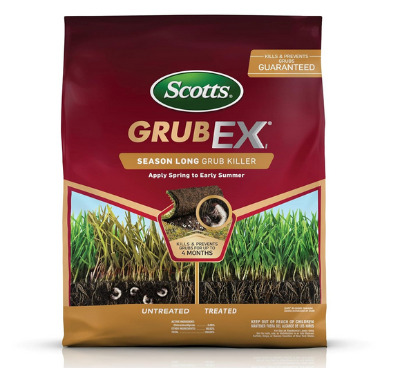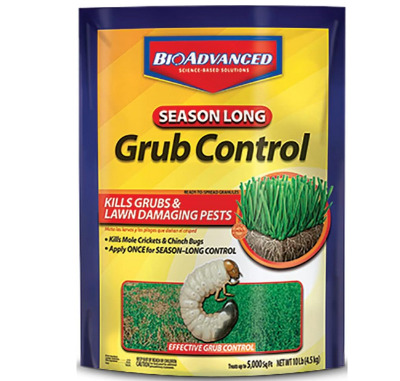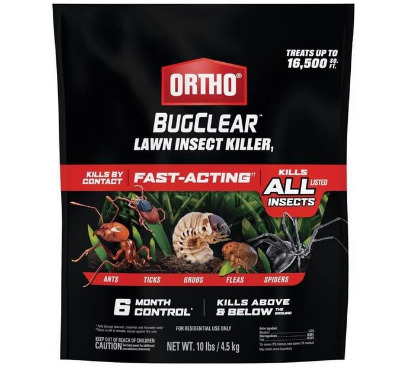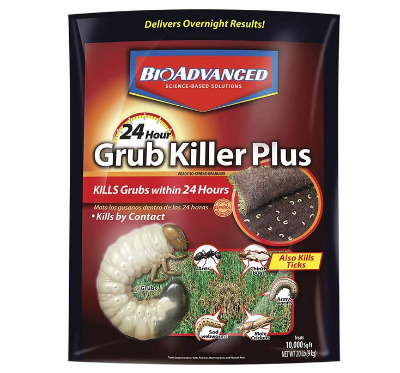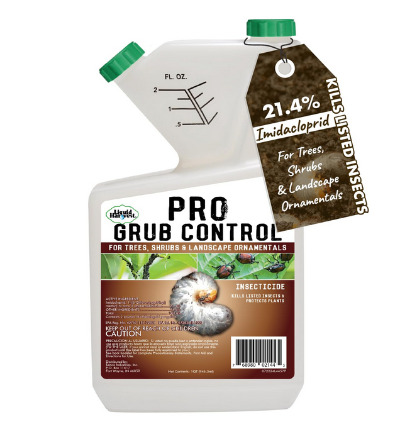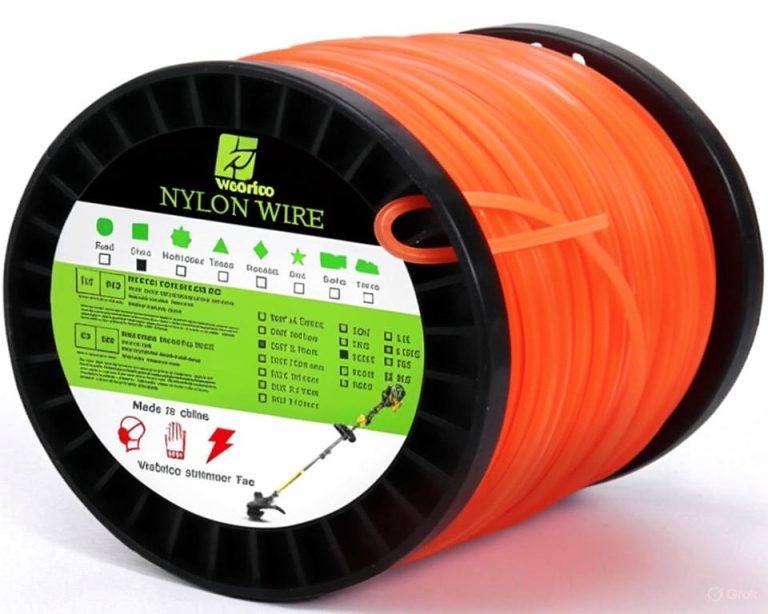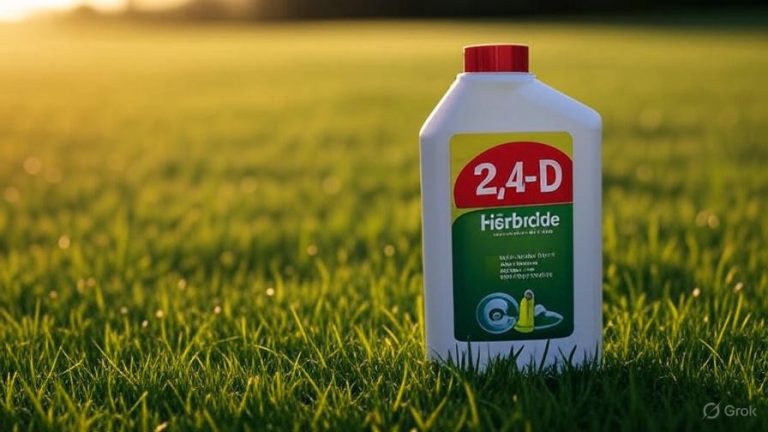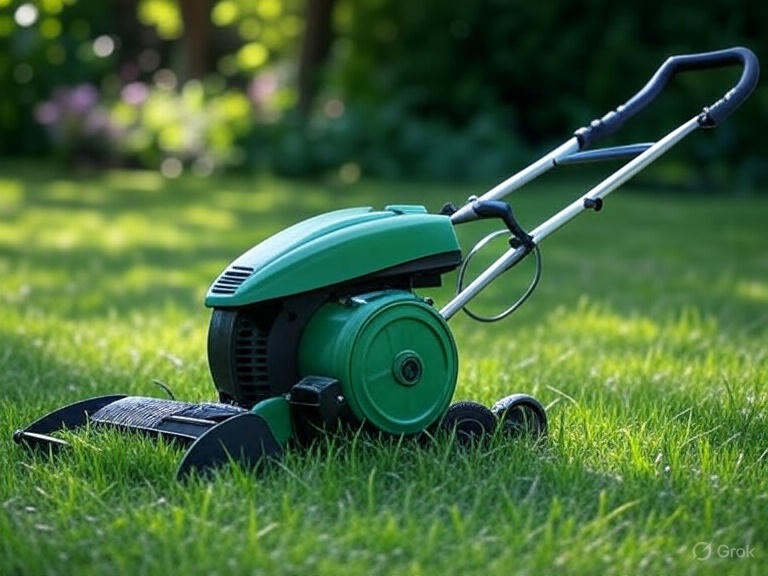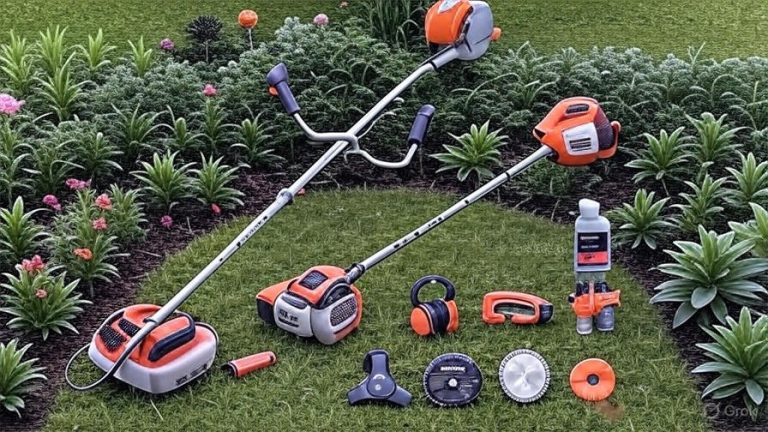5 Best Grub Killer for Lawn In 2025
Grubs silently destroy lawns from beneath the surface. These beetle larvae feed on grass roots, turning lush green turf into brown, dying patches. Homeowners often discover the damage too late when sections of lawn peel back like loose carpet. The right grub control product stops this destruction before it starts.
This comprehensive guide examines five proven grub killers that protect lawns from these destructive pests. Each product offers unique benefits for different lawn care needs, from preventative treatments to emergency rescue solutions.
Understanding Grub Damage and Control Options
White grubs represent the larval stage of various beetles, including Japanese beetles, June bugs, and European chafers. These C-shaped pests live underground during most of their lifecycle, consuming grass roots throughout their development. A healthy lawn can support a small grub population, but high infestations quickly cause serious damage.
Signs of grub infestation include irregular brown patches, spongy turf texture, and increased wildlife activity. Birds, skunks, and raccoons tear up lawns while hunting for these protein-rich larvae. Dead grass patches appear first in late summer through fall when grubs feed most actively.
Two main types of grub control products exist: preventative and curative treatments. Preventative formulas work best when applied before grubs hatch, while curative products kill existing larvae. The timing of application dramatically affects treatment success rates.
Product Reviews: Top Grub Killers for Lawn Protection
1. Scotts GrubEx1 Season Long Grub Killer – Best Overall Preventative Treatment
Coverage: 5,000 square feet
Weight: 14.35 pounds
Protection Duration: Up to 4 months
Scotts GrubEx1 stands as the gold standard for preventative grub control. This granular treatment stops grubs before they damage lawns, offering season-long protection with just one application. The formula kills 25% more grub types compared to the original GrubEx formulation.
Key Features and Performance
The active ingredient chlorantraniliprole works by disrupting the muscle function of target insects. This compound specifically targets beetle larvae without harming beneficial insects like earthworms when used as directed. Homeowners apply the granules using broadcast, drop, handheld, or Wizz spreaders.
Application timing matters tremendously with preventative treatments. Apply GrubEx1 during spring or early summer when adult beetles lay eggs. The granules must reach the soil where grubs feed, so water the lawn thoroughly after application. Dry conditions during application help the product stick to grass blades before irrigation.
Pest Control Spectrum
Beyond standard grub control, this formula handles multiple lawn pests. The treatment kills and prevents caterpillars, armyworms, chinchbugs, and various beetle species. Japanese beetle control improves with annual applications since the formula reduces next generation populations.
Real-World Performance
Field testing shows GrubEx1 delivers consistent results across different grass types. The four-month protection window covers peak grub feeding periods in most regions. Lawns treated in May typically show protection through September when grub damage normally peaks.
Some users report reduced mole and skunk activity after treatment. These animals dig up lawns searching for grubs, so eliminating the food source naturally discourages their presence. This secondary benefit often proves as valuable as the primary grub control.
Application Tips for Best Results
Start with accurate lawn measurements to avoid under-application. Apply to dry grass on a calm day to prevent product drift. Water immediately after spreading, using at least half an inch of irrigation. The moisture activates the granules and carries the active ingredient into the root zone.
Cool-season grass owners should apply during late spring. Warm-season grass regions benefit from early summer applications. Both timing windows catch grubs in their most vulnerable early stages.
Pros:
- Single application protects for four months
- Controls multiple beetle larvae species
- Safe for established lawns when used correctly
- Compatible with standard lawn spreaders
- Reduces secondary pest damage from digging animals
Cons:
- Works only as a preventative measure
- Requires precise timing for maximum effectiveness
- Must water thoroughly after application
- Not effective against mature grubs
- Premium price point compared to generic alternatives
Best For: Homeowners who plan ahead and want comprehensive season-long protection against grub damage with minimal effort.
2. BioAdvanced Season Long Grub Control – Best Value for Large Lawns
Coverage: 5,000 square feet (10 lb bag)
Weight: 10 pounds
Protection Duration: Season-long control
BioAdvanced Season Long Grub Control delivers reliable protection at an attractive price point. This preventative treatment uses similar technology to premium products but comes in a more economical package. Large property owners particularly appreciate the cost-effectiveness.
Formula and Active Ingredients
The imidacloprid-based formula provides systemic protection by creating a barrier in the soil. Grubs consume the treated grass roots and stop feeding within days. The product remains active in the root zone throughout the growing season, continuously protecting against new hatches.
Application Method and Coverage
The ready-to-spread granules work with any standard broadcast or drop spreader. Coverage remains consistent when spreader settings match label recommendations. A 10-pound bag treats 5,000 square feet, making calculations straightforward for different lawn sizes.
Application windows match other preventative treatments. Late spring to early summer provides optimal results in most climate zones. The product needs watering-in to move the active ingredient into the soil profile where grubs feed.
Performance Characteristics
Field observations show BioAdvanced performs comparably to higher-priced alternatives. The season-long protection claim holds true when applied correctly and timed properly. Lawns maintain healthy root systems throughout peak grub feeding periods.
The formula targets various white grub species, including Japanese beetle, European chafer, and June bug larvae. This broad-spectrum approach ensures protection against the most common lawn-damaging beetles. Root-feeding protection translates to stronger, healthier turf all season.
Value Proposition
Cost per square foot runs lower than premium brands while maintaining effective grub control. Bulk buyers who treat large properties find significant savings. The product quality justifies the price, delivering professional results without professional costs.
Pros:
- Excellent value for coverage provided
- Season-long protection from single application
- Compatible with all standard spreaders
- Broad-spectrum grub control
- Effective against multiple beetle larvae species
Cons:
- Requires water activation after application
- Preventative only, not curative
- May need supplemental treatment in heavy infestation areas
- Timing critical for success
- Limited availability in some regions
Best For: Budget-conscious homeowners with large lawns who need reliable preventative grub control without premium pricing.
3. Ortho BugClear Lawn Insect Killer1 – Best Multi-Purpose Pest Control
Coverage: Up to 16,500 square feet
Weight: 10 pounds
Protection Duration: 6 months for ants, 3 months for other listed pests
Ortho BugClear breaks from traditional single-purpose grub killers by addressing multiple lawn pest problems simultaneously. This versatile formula kills grubs while controlling ants, spiders, ticks, fleas, armyworms, and various beetles. Homeowners dealing with multiple pest issues find exceptional value in this comprehensive approach.
Dual-Action Formula
The product works both above and below ground, targeting surface-dwelling insects and subterranean grubs. This dual-action capability eliminates the need for separate treatments. Contact kill provides immediate results against visible pests, while residual protection prevents reinfestation.
Bifenthrin serves as the active ingredient, delivering broad-spectrum insect control. This synthetic pyrethroid disrupts insect nervous systems on contact. The compound binds to soil particles, creating a protective barrier that remains effective for months.
Coverage and Application
A single 10-pound bag treats up to 16,500 square feet, offering exceptional coverage. This efficiency makes the product ideal for large properties where multiple pest problems exist. The granules spread easily with Scotts-compatible spreaders, ensuring even distribution.
Apply at the first sign of insect activity or damage. The fast-acting formula begins killing lawn bugs within minutes of contact. Post-application watering helps the product reach grubs in the soil while activating the barrier protection for surface insects.
Comprehensive Pest Control
The insect control spectrum extends well beyond grubs. Ants receive six months of control, making this an excellent perimeter treatment. Ticks and spiders face three months of protection, critical for families with children or pets. Fleas die on contact, helping control outdoor populations before they enter homes.
Armyworm control protects grass from these voracious caterpillars. Beetle control covers both adults and larvae, disrupting pest lifecycles. This comprehensive approach reduces overall pesticide use by consolidating treatments.
Practical Applications
Homeowners use BugClear on lawns, ornamental plantings, home perimeters, flower beds, and listed vegetable plants. This versatility reduces product inventory while maintaining protection across different landscape areas. A single product handles most outdoor pest problems.
The extended protection periods reduce application frequency. Six months of ant control means treating once during spring for season-long relief. Three-month protection for other pests typically requires only two applications per season.
Safety and Environmental Considerations
Follow label directions carefully, as bifenthrin affects a wide range of insects. Avoid application near water bodies since pyrethroids impact aquatic organisms. Keep pets and children off treated areas until the product dries completely.
Pros:
- Kills multiple pest types with single application
- Exceptional coverage per pound
- Works above and below ground
- Extended protection periods reduce reapplication needs
- Fast-acting contact kill for immediate results
- Suitable for lawns, gardens, and home perimeters
Cons:
- Broad-spectrum formula affects beneficial insects
- Requires careful application near water sources
- Not suitable for all vegetable plants
- May need additional treatments for severe grub infestations
- Shorter protection period for grubs than specialized products
Best For: Homeowners battling multiple pest problems who want comprehensive control from a single product application.
4. BIOADVANCED 24 Hour Grub Killer Plus – Best Emergency Treatment
Coverage: 10,000 square feet (20-pound bag)
Weight: 20 pounds
Kill Speed: 24 hours
BIOADVANCED 24 Hour Grub Killer Plus serves as the emergency response team for grub infestations. When brown patches appear and wildlife tears up the lawn, this fast-acting formula delivers overnight results. The curative approach targets existing grub populations rather than preventing future infestations.
Rapid-Action Formula
Trichlorfon provides the knockdown power behind this emergency treatment. This organophosphate insecticide kills grubs through direct contact within 24 hours. The speed makes it ideal for stopping ongoing damage quickly before more turf dies.
Unlike preventative treatments that work gradually over weeks, this formula demands immediate action from homeowners who discover active infestations. The rapid kill stops feeding damage instantly, giving lawns a chance to recover before complete root destruction occurs.
Application Strategy
Apply only when grubs or listed pests are actively present. Visual inspection reveals grubs by pulling back a section of damaged turf. Count grubs in a square foot section – five or more per square foot indicates treatment necessity. Apply early morning or evening when grubs feed closest to the surface.
Water thoroughly after application to move the active ingredient into the soil. Grubs must contact the treated soil for the formula to work. Adequate irrigation ensures the product reaches the proper depth where grubs live.
Treatment Timing
This curative product works best during active grub feeding periods. Late summer through fall represents prime treatment time when grubs feed heavily before winter. Early spring offers a second window when grubs resume feeding after cold weather.
The 24-hour kill speed allows homeowners to treat and see results almost immediately. This quick feedback confirms treatment success and prevents continued damage. Severely infested areas may require follow-up applications for complete control.
Pest Control Beyond Grubs
The formula kills ants, armyworms, billbugs, chinch bugs, crickets, and other listed lawn pests. This extended control helps with multiple problems simultaneously. The contact kill works on both adult insects and larvae, disrupting pest populations at multiple life stages.
Turf Rescue Capabilities
Damaged lawns benefit from the rapid action. Stopping grub feeding immediately prevents further root damage. Grass plants with some intact roots can recover when pest pressure ends. The formula gives struggling turf a fighting chance by eliminating the primary stressor.
Recovery depends on damage extent. Light to moderate feeding damage often reverses with proper care after treatment. Severely damaged areas may require overseeding once pest control succeeds.
Pros:
- Kills grubs within 24 hours
- Excellent emergency treatment for active infestations
- Works on multiple lawn pest species
- Visible results confirm treatment success
- Stops ongoing damage immediately
- Larger bag size covers substantial area
Cons:
- No preventative protection
- Requires active infestation for use
- Organophosphate active ingredient needs careful handling
- More expensive per application than preventatives
- May need multiple treatments for severe cases
- Does not prevent future infestations
Best For: Homeowners facing active grub infestations who need immediate results to stop ongoing lawn damage.
5. Pro Grub Control – Best Concentrated Professional Formula
Coverage: Varies based on dilution (32 oz concentrate)
Active Ingredient: Imidacloprid (21.4%)
Application Method: Liquid concentrate requires mixing
Pro Grub Control brings professional-grade performance to residential applications. This concentrated liquid formula contains 21.4% imidacloprid, the same active ingredient professionals use. The concentrate format offers flexibility for treating trees, shrubs, landscape ornamentals, and lawns.
Professional-Grade Concentration
The high active ingredient percentage means a small amount treats large areas. Homeowners dilute the concentrate according to target pest and plant type. This flexibility allows customized treatments for different situations, from delicate ornamentals to tough lawn grasses.
Concentrated formulas prove more economical for regular users. A single 32-ounce bottle provides multiple treatments depending on dilution rates. Professionals and serious gardeners appreciate the value proposition.
Broad Application Range
Unlike lawn-only products, Pro Grub Control treats trees, shrubs, and ornamental plants. Japanese beetle control on roses demonstrates the versatility. Aphid control on ornamentals shows the formula’s reach beyond grubs.
The systemic action means plants absorb the active ingredient through roots or foliage. This provides inside-out protection against feeding insects. Grubs consuming treated roots receive a lethal dose, while aphids feeding on treated leaves face the same fate.
Target Pest Spectrum
Grub larvae control remains the primary use, but the formula handles numerous other pests. Japanese beetles, weevils, adelgids, leaf miners, and scale insects all fall under its control spectrum. This makes it valuable for comprehensive landscape pest management.
Application Methods
Soil drenching works best for grub control. Mix the concentrate according to label rates and apply to the soil around affected plants. The product moves into the root zone where grubs feed. Foliar sprays control above-ground pests on shrubs and ornamentals.
Application timing follows standard grub control principles. Late spring to early summer prevents grub damage. Fall applications can provide some control but work less effectively than spring treatments.
Technical Considerations
Liquid application requires spray equipment or watering cans. Accurate mixing ensures proper concentration. Too weak proves ineffective, while too strong wastes product and risks plant damage. Follow label instructions precisely for best results.
Calculate total area and plant numbers before mixing to avoid waste. The concentrate remains stable in storage when kept in original containers. Partial bottles last multiple seasons when stored properly.
Professional Results
The high concentration delivers professional-level control. Landscapes with diverse plantings benefit from the multi-use capability. One product handles lawn grubs, tree borers, and shrub pests.
Systemic protection lasts throughout the growing season with proper application. Plants treated in spring maintain protection through summer. This extended control reduces the need for repeated applications.
Pros:
- Professional-grade concentration
- Treats lawns, trees, shrubs, and ornamentals
- Economical concentrated format
- Controls wide range of pests beyond grubs
- Systemic action provides lasting protection
- Flexible dilution for different applications
Cons:
- Requires accurate mixing and calculation
- Needs spray equipment for application
- More complex than ready-to-use granules
- Risk of over or under application
- Not ideal for homeowners wanting simple solutions
- Liquid storage requires proper facilities
Best For: Experienced gardeners and landscape professionals who need versatile pest control for diverse plantings and want professional-grade performance.
Grub Control Application Guide
Success with grub killers depends heavily on proper application technique. The following guidelines ensure maximum effectiveness regardless of which product you choose.
Timing Your Treatment
Preventative treatments work best when applied before grubs hatch. Adult beetles emerge from soil during late spring, mate, then lay eggs in turf. Eggs hatch into tiny grubs that begin feeding immediately. Applying preventative products before or during this egg-laying period provides optimal protection.
Late spring through early summer represents the ideal preventative window in most regions. Southern areas may need earlier applications, while northern climates allow slightly later timing. Local agricultural extension offices provide specific timing recommendations for your area.
Curative treatments target existing grubs. Late summer through early fall offers the best curative window when grubs feed most actively. Early spring provides a secondary opportunity before grubs pupate into beetles.
Application Technique
Granular products require even distribution across the lawn. Calibrate spreaders according to product labels to ensure correct application rates. Walk at a steady pace, overlapping passes slightly to prevent missed strips.
Apply to dry grass during calm weather. Wind blows lightweight granules off target, while wet grass causes granules to clump. Morning applications avoid afternoon winds in many areas.
Post-Application Care
Water immediately after applying most grub control products. The irrigation moves active ingredients into the soil where grubs feed. Apply at least half an inch of water, measuring with rain gauges or tuna cans placed in the lawn.
Continue normal lawn care after treatment. Mowing, fertilizing, and regular watering proceed as usual. The products work beneath the surface without interfering with standard maintenance.
Safety Precautions
Keep children and pets off treated areas until granules dissolve completely. Follow all label directions regarding reentry times. Store unused products in original containers away from children and pets.
Avoid application near wells, streams, ponds, or other water bodies. Some active ingredients harm aquatic organisms. Buffer zones protect sensitive areas.
Measuring Treatment Success
Check for grubs six weeks after treatment by examining soil beneath turf. Dig small inspection holes in previously damaged areas. Fewer than five grubs per square foot indicates successful control.
Monitor lawn health throughout the season. Green, vigorous grass with strong root systems signals effective grub control. Continued damage suggests treatment failure or reinfestation requiring additional applications.
Integrated Grub Management Strategies
Chemical control represents just one component of effective grub management. Combining multiple strategies creates more resilient lawns and reduces reliance on pesticides.
Cultural Controls
Healthy lawns tolerate grub feeding better than stressed turf. Proper fertilization, adequate watering, and correct mowing height create vigorous grass that outgrows moderate grub damage. Strong root systems compensate for some grub feeding.
Avoid overwatering during adult beetle flight periods. Japanese beetles and other lawn-damaging species prefer moist soil for egg-laying. Drier conditions during June and July discourage egg-laying in some regions.
Biological Controls
Beneficial nematodes attack grubs naturally without chemicals. These microscopic worms enter grubs and release bacteria that kill the host. Nematodes work best when applied during warm weather to moist soil.
Milky spore disease specifically targets Japanese beetle grubs. This naturally-occurring bacteria infects larvae and spreads through soil over time. The biological control takes several seasons to establish but provides long-term suppression.
Physical Controls
Hand-picking adult beetles from plants reduces next-generation grub populations. Drop beetles into soapy water to kill them. This labor-intensive approach works for small properties or isolated infestations.
Trapping adult beetles sounds appealing but often attracts more beetles to your property. Research shows traps may increase local damage rather than reduce it. Skip beetle traps and focus on larval control instead.
Threshold-Based Treatment
Not every lawn requires treatment. Count grubs in affected areas before applying products. Fewer than five grubs per square foot rarely justifies treatment in most situations. Healthy lawns tolerate this population level without significant damage.
Treat only when populations exceed thresholds or when lawn health warrants intervention. This targeted approach reduces unnecessary pesticide use while protecting lawns that truly need help.
Common Questions About Grub Control
How long do grub killers take to work?
Preventative products require several weeks to establish protection. The active ingredients need time to distribute through the soil. Grubs die when they hatch and consume treated roots, which happens gradually over weeks.
Curative products like BIOADVANCED 24 Hour Grub Killer work much faster. These emergency treatments kill existing grubs within 24 hours through direct contact. The rapid action stops ongoing damage immediately.
Can you apply grub killer and fertilizer together?
Some products combine grub control with fertilizer for convenience. However, most grub killers work independently of fertilizer. You can apply them separately on the same day if both products allow. Check labels for specific guidance on combined applications.
Timing considerations matter more than physical compatibility. Grub control timing doesn’t always align with optimal fertilizer timing. Prioritize grub control timing for best pest management results.
Do grub killers harm beneficial insects?
Product formulations vary in their impact on beneficial insects. Targeted products like those containing chlorantraniliprole specifically affect beetle larvae while sparing beneficial insects like earthworms. Broad-spectrum products impact a wider range of insects.
Follow label directions to minimize unintended effects. Apply only when necessary and at recommended rates. Avoid treating flowering plants when pollinators are active.
How often should you apply grub killer?
Preventative treatments typically require annual application. Apply each spring to prevent that season’s grub population. Some products offer multi-season protection, reducing application frequency.
Curative treatments may need repeating if infestations recur. Address underlying factors attracting beetles to your lawn. Healthy turf maintenance reduces the need for repeated treatments.
Will grub killer revive dead grass?
Grub killers eliminate the pest but don’t repair damage. Dead grass requires reseeding or resodding after pest control succeeds. Grass with intact roots may recover once grub pressure ends.
Time recovery efforts properly. Wait until pest control takes effect before investing in renovation. Otherwise, new grass faces the same grub pressure that damaged the original turf.
Making Your Decision
The best grub killer for your lawn depends on several factors: current infestation status, lawn size, budget constraints, and pest control philosophy.
Scotts GrubEx1 suits homeowners who plan ahead and want comprehensive season-long prevention. The four-month protection window and broad grub spectrum justify the premium price for many users.
BioAdvanced Season Long Grub Control delivers excellent value for large properties. The economical pricing doesn’t sacrifice performance, making it ideal for budget-conscious homeowners with substantial lawn areas.
Ortho BugClear works best when multiple pest problems exist simultaneously. The comprehensive pest control reduces product inventory and application frequency, saving time and money.
BIOADVANCED 24 Hour Grub Killer Plus serves as emergency treatment for active infestations. The rapid action stops damage immediately, making it invaluable when brown patches appear unexpectedly.
Pro Grub Control targets professional users and serious gardeners. The concentrated formula offers flexibility and economy for treating diverse landscapes beyond basic lawn care.
Conclusion
Protecting your lawn from grub damage requires the right product applied at the proper time. Preventative treatments work best when applied before eggs hatch, while curative products address existing infestations. Each product reviewed here excels in specific situations.
Start by assessing your lawn’s current condition. No visible damage suggests preventative treatment provides adequate protection. Brown patches and heavy wildlife activity indicate a need for emergency curative treatment.
Consider your commitment to lawn care timing. Preventative products require precise spring application for maximum effectiveness. Missing the application window reduces treatment success dramatically. Emergency treatments offer flexibility for homeowners who struggle with scheduled maintenance.
Budget plays a role in product selection. Premium preventative treatments cost more upfront but often prove more economical than repeated curative applications. Calculate cost per square foot rather than per bag price to understand true value.
Environmental concerns influence product selection. Some homeowners prefer targeted products with minimal impact on beneficial insects. Others accept broader-spectrum control for comprehensive pest management. Review active ingredients and make informed decisions based on your priorities.
Remember that chemical control represents one component of effective grub management. Maintain healthy lawns through proper cultural practices. Strong, vigorous grass tolerates some grub feeding without significant damage. Combine chemical and cultural controls for optimal results.
Success stories from satisfied homeowners prove these products work when applied correctly. Timing, technique, and product selection all contribute to effective grub control. Follow label directions precisely and adjust timing to your local conditions.
Your lawn deserves protection from these destructive pests. The products reviewed here provide proven solutions for various situations and budgets. Choose the option that matches your needs, apply it correctly, and enjoy a healthy, green lawn free from grub damage.


